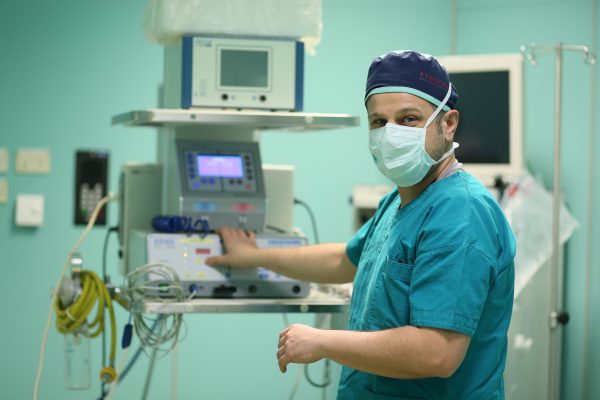The Casa di Cura San Giovanni clinic is a centre of excellence in the field of spinal surgery, aimed at surgically resolving pathologies affecting the back (fractures, hernias, stenosis, etc.).
Vertebral fractures
As far as the treatment of vertebral fractures is concerned, stabilisation and vertebroplasty are the primary types of interventions used. Stabilisation refers to the application of metal plates, screws and bone grafts to keep two adjacent vertebrae strong and stable. On the other hand, vertebroplasty relates to the cementing of the fractured vertebrae through a percutaneous injection of a cementing substance.
Cervical and lumbar herniated disc surgery
Herniated disc surgery is performed following a rupture of an intervertebral disc, whose fibrous-elastic material flows out from its natural home between two vertebrae and causes a compression of the nerve roots resulting in back pain (lumbago, sciatic, radiculopathy) and/or tingling and numbness of the lower limbs (paresthesias). In severe cases a hernia can lead to difficulty moving, paresis and cauda equina syndrome. The surgical intervention consists in the removal of the herniated disc. Different types of interventions area available to treat the condition. The simple diskectomy refers to the excision of the hernia through a partial or total microsurgical removal of the nucleus pulposus. Laser ablation, on the other hand, uses high frequency energy to vaporize the nucleus pulposus, while a discogel injection refers an injection of gelled alcohol inside the herniated disc to reduce the pressure on the nerve roots.
Cervical and lumbar canal stenoses surgery
Cervical canal stenosis is a condition in which the affected individual experiences a reduction in the diameter of the cervical vertebral canal, causing painful symptoms that can range from neck pain in milder cases, to the onset of a myelopathy manifested by weakness in the limbs, reduced reflexes, difficulty walking with eventual spasticity in more advanced cases. Lhermitte’s phenomenon is a characteristic sign of the condition (generalised feeling of electric shock resulting from flexion of the neck). Spinal canal decompression surgery can be performed through a laminectomy (complete excision of the more or less laterally expanded lamina, which almost always involves the need to also stabilise the levels concerned) or a so-called “open-door” laminotomy (the lamina are sectioned on one side only and weakened on the opposite side thus facilitating the opening of the lamina in blocks, similar to a zipper; thanks to this approach, instability is not introduced and a fixation device is not necessary).
Vertebral arthrodesis
In case of degenerative spine conditions and/or instability of the same, it is possible to resort to vertebral arthrodesis surgery, which allows, using metallic or non-metallic implants (cages, plate-cages, screws, plates, rods, hooks) to join and set spinal bones and to stabilise the spine, reducing the associated pain and deformities.
Spondylolisthesis
Spondylolisthesis is a condition characterised by a slow and progressive forward sliding of a vertebra with respect to the one below, which causes lower back pain, generally accentuated by rapid or sudden movements and/or physical exertion. The surgical intervention consists of a lumbar fixation: using bone grafts and tools such as metal plates and screws, this procedure makes it possible to merge or to create a link between two or more adjacent vertebrae. This intervention aims to stabilise the spine and relieve pain.

